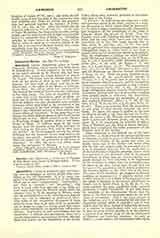

Amorbach, former Benedictine abbey in Lower Franconia (Bavaria), about twenty-five miles south of Aschaffenburg. It was founded in the early part of the eighth century by St. Pirmin, who had been called to that region by Count Ruthard to preach the Gospel. The Saint, with his disciple Amor, first took up his abode at what is now called Amorbrunnen, but later built an abbey near by, in the Oden forest, in the valley of the Mudau, a tributary of the Main. The abbey, which was consecrated in 734, became the center of Christianity and civilization in the Oden forest. The town of Amorbach, which in 1900 had 2,173 inhabitants, grew up about its walls and its monks not only labored in the neighboring districts but also penetrated into northern Germany, where they aided in the conversion of the Saxons. Several of the first bishops of Verden, the scene of the missionary activity of these monks, were former abbots of Amorbach. In the early days of its history the abbey received generous gifts from Charles Martel and his sons. Pepin united it to the Diocese of Wurzburg, though in modern times it was transferred to Mainz. It suffered much in the tenth century from the invasion of the Huns, and later, in 1521, during the Peasants’ War, and in 1631, from the Swedes. In the seventeenth century the abbey buildings and the beautiful church, long famous for its organ, were rebuilt. Amorbach was suppressed in 1803 and passed into the possession of the house of Leiningen. In 1816, the town and abbey came under the jurisdiction of Bavaria.
H. M. BROCK

